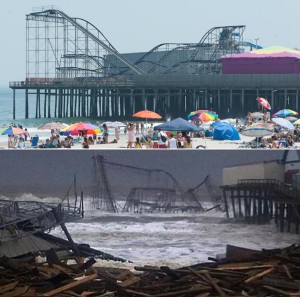On August 17, 2015, I attended the Board of Public Utilities, BPU, hearings regarding New Jersey’s Energy Master Plan, EMP.
A lot of people, myself included, spoke about Sandy. (Photos, click here).
Many spoke of the need for the BPU to act independently of the Governor and think long term.
No one spoke about a need or want for more fossil fuels or more nuclear.
The lobbyist from the NJ GCA, The Gasoline, C-Store, Automotive Association told the commissioners how happy he was that he installed a solar energy system on his home and said that gas stations need robust electricity. They can’t simply install emergency generators that burn diesel or gasoline.
I called for: 140% clean, renewable, sustainable electricity by 2030:
- Solar: 3.5 GW
- Wind: 3.5 GW
- Batteries: 1.5 GW
- Biofuel: 1.5 GW
Including:
- 250 MW of solar in a 100 KW array on each of the 2500 public schools,
- 125 MW of battery backups, in a 50 KW Tesla Powerwall or equivalent system on each public school,
- These would give us emergency shelters, with power, in every community in New Jersey.
- A Capstone microturbine, or the equivalent at each sewage treatment plant.
These, I explained, would make the grid more resilient.
I also added that Wall Street appears to be abandoning fossil fuels. This observation is based on the data collected from Dec. 12, 2012, and published on Popular Logistics, here, that show that for the period from Dec. 21, 2012 to July 21, 2015,
- Sustainable Energy: Up 121%, 46.7% per year.
- Fossil Fuel: DOWN 25% overall, -9.26% per year,
- S&P 500: Up 47.54%, 18.41% per year.
The full text of my prepared remarks is below:
Re: The NJ Energy Master Plan
I represent Popular Logistics, a think tank focused on energy, economics and the environment.
As of December 31, 2014, New Jersey had 1.5 gigawatts (GW) of solar capacity (Solar Energy Industry Association, SEIA.org). As I see it, we could reach the Renewable Portfolio Standard (RPS) goal of 30% by 2020 (here). That would be great.
But Scotland had 2.6 GW of renewable capacity at the end of 2007, and 7.3 GW by the end of 2014. Denmark, using renewables, meets and exceeds its electricity demand by 40%. This should be our goal: 10 GW140%, of clean, renewable electricity by 2030, as follows:
- 3.5 GW of solar.
- 3.5 GW of wind.
- 1.5 GW of batteries,
- 1.5 GW of biofuel from agricultural waste, food waste and sewage.
Solar should be 35% of our generation capacity. Looking at the microeconomic level, Stocton, Rutgers, Toms River High have solar and solar schools are great! The plan should call for 250 MW in a 100 KW solar array on each of New Jersey’s roughly 2500 Public schools. The taxpayers pay the operating costs for the schools, and solar is competitive, so in the long run this could save the taxpayers money.
Batteries – While we’re at it, the plan should call for – and the taxpayers should fund – 125 MW in 50 KW Tesla Powerwall batteries, or the equivalent, and a grid disconnect switch, on each solar powered school. This would give us emergency shelters – with power – in every community in New Jersey, hardening the grid, strengthening our communities.
Wind – 350 Sea Titans, or the equivalent, at 10 MW each, would give us 3.5 GW of nameplate capacity offshore wind – and create artificial reefs, nurturing fish, birds, whales, fishing and tourism.
Biofuel – Utility authorities transform raw sewage into clean water and methane. A few years ago I was told that the Western Monmouth plant in Manalapan uses about one third of the methane it produces to treat incoming sewage, and wastes two thirds. Burning the methane in a Capstone turbine, or the equivalent, would create electricity and save the taxpayers money. The Plan should call for turbines at each sewage treatment plant. This would further diversify the energy supply, hardening the grid.
The Externalities – the Side Effects – of 10 GW of Clean Renewable Energy:
- Artificial reefs which nurture fish, birds, whales, dolphins, and us,
- No toxic waste,
- No radioactive waste,
- Very little carbon dioxide and no carbon dioxide from fossil fuels,
- A stronger, hardened, more flexible grid, and
- Good jobs.
After meeting and exceeding these goals, you will be unsung heroes of New Jersey’s Energy Infrastructure.

